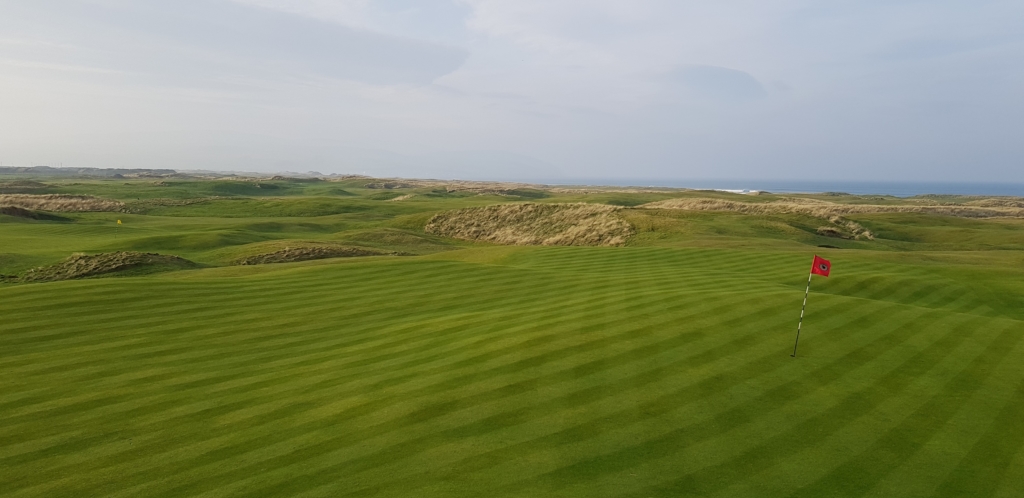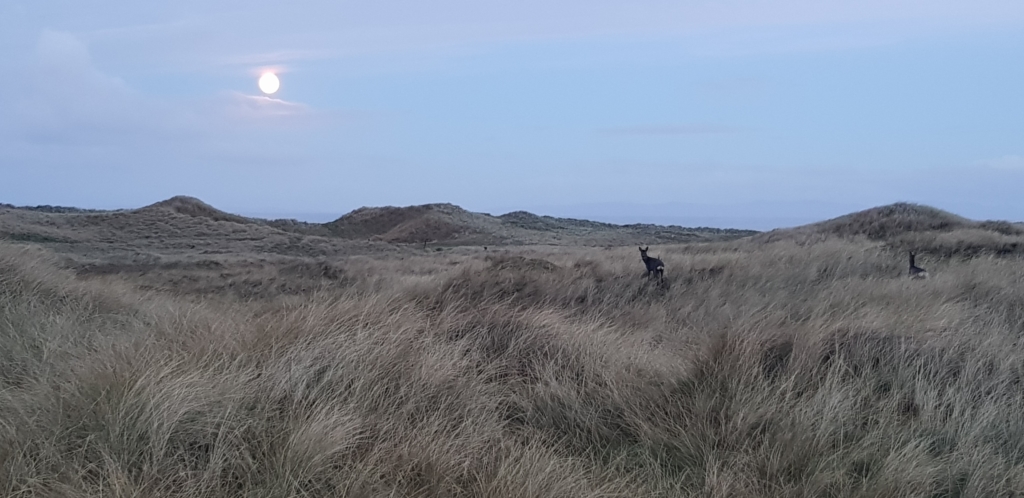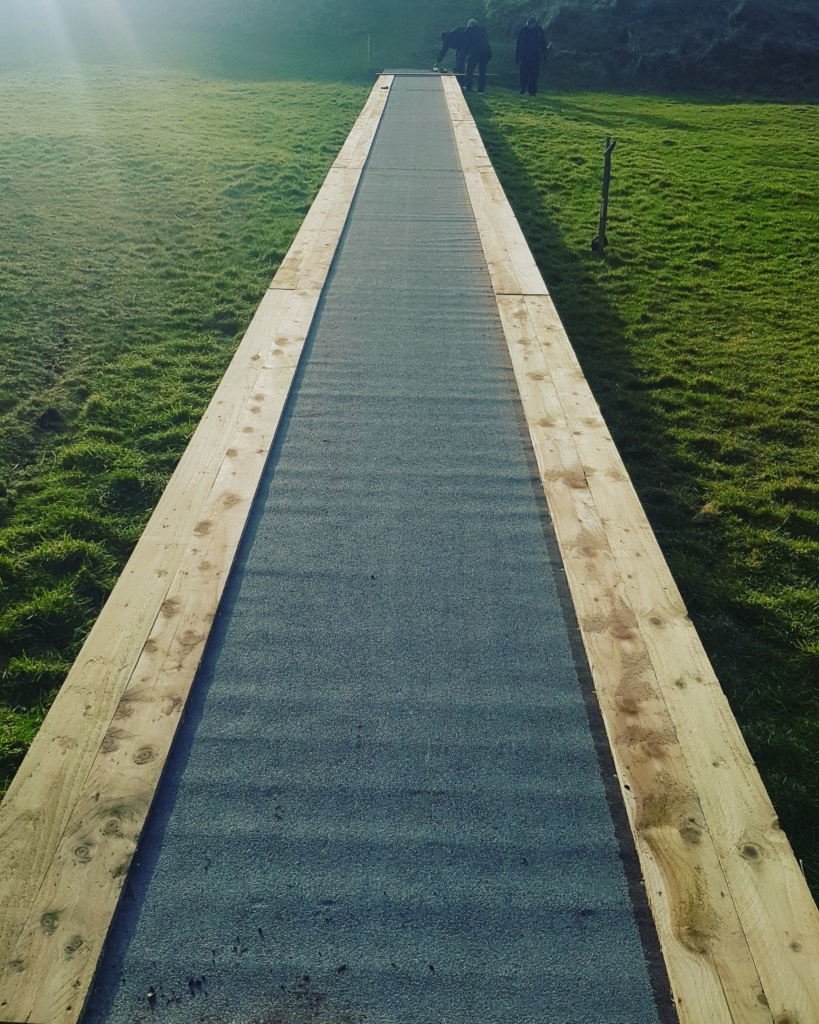I would love to tell you that the reason why I haven’t updated this blog for a while is that I’ve been so busy out on the course, but the truth is I’ve just been a bit slack with it. Not to worry though, like the prodigal son, I’m back!
So what have I got to say for myself? Well, even though I haven’t penned one of these reports for a while, I haven’t forgotten that I always start by talking about the weather…and, up until the last couple of weeks, how good has that been over the course of this winter! Unsurprisingly, given the benign conditions and unusually high levels of sunshine, the fine turf areas at Machrihanish Dunes are currently looking pretty good- with excellent coverage of grass on greens, tees, and surrounds. We have completed all the projects that we had allocated for ourselves in our winter program, and these re-turfed areas have been rooting happily in the late winter sunshine. I could describe all that we have done in great detail, but I am so pleased with the outcome of some of these jobs that I would really rather you come down and have a look yourself than get a disappointingly two-dimensional preview here. Suffice it to say, this is the most excited I have been heading into a golf season here. I really think we have made some hugely positive changes to the course and when that is combined with the current good quality of the turf surfaces, I think it will be hard not to enjoy a game at Machrihanish Dunes this spring.

Ten-Year Celebrations
As I am sure you are aware, Machrihanish Dunes celebrates its 10th anniversary in 2019. Having only been here for half of that decade I feel like a bit of a fraud opening discussions about how the course has changed and matured during that time, but I thought it might be interesting to note why things invariably get easier for us greenkeepers once a golf course has had time to settle in. It would seem pretty obvious to start a series such as this with the greens, so let’s just do that.
The southwest coast of Scotland is a harsh environment in which to maintain grass at greens height. Due to the warming effect of the gulf stream, we are plagued by higher than Scottish average temperatures throughout late autumn and early winter. Now, it might be natural to imagine that higher temperatures would give us the opportunity to grow grass when others could not and would therefore give us the opportunity to recover better and more quickly from disease, scars or salt damage incurred during the relentless gales. But that advantage is tempered by the constant battle to keep the plant energised during periods where there is very little available sunlight. We have all been told that it takes more electrical energy to switch a light bulb on and off than it does to leave it on, and this expenditure of energy is very similar to the effect we see when we try to maintain grass at the exact temperature where it wants to start growing, but then it stops growing, then starts again, then stops again. The fine-leaved perennial grasses that we would prefer to grow in our greens find it difficult to break down and utilise the nutritional inputs that we add when levels of sunlight, and therefore levels of available energy, are low and this is when they turn to their reserves of food in the soil, most of which is produced and plated up for them by colonies of hard-working bacteria and micro-organisms (which themselves survive by munching through organic matter deposited by decaying plants, clippings spilled from mower boxes, and windblown debris). Obviously, it is extremely advantageous to us that these unseen friends of ours chew through so much of this unwanted material, because if they didn’t it would accumulate in our rootzones and then we would have to holocore or scarify it out. We absolutely hate holocoring and we know that you hate it too, so we will do anything we can to minimise the number of big holes we need to make in the greens. Promoting the health of the organisms that degrade thatch and turn it into useable plant food is massively important to us, as we know this process naturally continues into the shoulder months when our precious perennial plants are looking for nutrition that they just don’t have the energy to get from converting food that we give them into a form that can help preserve their health and very existence.
This self-sufficiency is one of the main reasons why the greens at Machrihanish Dunes are so much easier to manage now through the autumn and winter than they were 10 years ago when the course opened. Initially, the newly constructed greens had a very sandy make-up. This leached nutrients frighteningly quickly and provided little or no potential food for the bacterial population which might have chosen to make the rootzones their home and would then have helped our hungry, energy-depleted grass plants through the difficult shoulder months when temperatures were comparatively high and light energy almost impossible to come by. We have worked hard over the last few seasons to improve the environment under our surfaces by using sensible topdressings and humus-rich fertilisers, with the hope being that we can provide an environment in which nature can take over and colonise the soil under our precious turf. We have purposefully excluded products that harm the health of the soil food web, although I will admit that we recently had some of those damaging products forcibly taken out of our hands by legislation. We have attempted to speed this whole process of naturalisation along by using compost teas and biological products which add life to the soil and assist that life to survive and to become self-sufficient by going to work on our organic matter and turning it into natural food for plants to uptake through their roots.
There are places in the world where reliance on the natural processes that deplete unwanted accumulations of decaying organic matter and cleverly process that into available plant food is of minimal importance, because the seasons are more clinically defined and there is a clear break between the times of year a plant is actively growing and the times of year when it is absolutely dormant. Vast areas of the U.S.A and Canada would come into this category for instance, as would a lot of central and Eastern Europe. The west of Scotland is not one of those places, though, and I believe that an increased reliance on promoting natural processes and the health of soil biology is the best way to help our surfaces to survive healthily through the seemingly never-ending muggy darkness of autumn and early winter. If we can harness nature to provide plant food at the exact times it is required, to help reduce organic build-up (so we can avoid having to rely on excessive aeration), to increase disease resistance and reduce the harmful build-up of hydrophobic deposits then we will be able to reduce our fertiliser and water inputs and hopefully rely less on fungicides and artificial wetting agents in the future. The less of these inputs we have to make, the more nature will thrive, and the more nature thrives, the less inputs we will be forced to make!

Competition Season Is Coming
It is hard to believe that we are talking about this already, but the golfing year is almost upon us. It always seems like January wants to last forever, but once that is finally past, the Masters is with us in the blink of an eye! Of course, this feeling is exacerbated at Machrihanish Dunes because we have quite a few competitions early in the calendar, and once again this starts with our Am-Am on Sunday, 7th April. Holding an Am-Am on the same weekend Dunaverty has historically held theirs worked well for us last year so we have decided to team up with them once again for our mutual benefit. They hold their competition on the Saturday, we offer a competitor’s rate in the hotels and cottages, and then hold our identical tournament on the Sunday. Everyone should be a winner with an arrangement like that in place.
The weekend after this (13th/14th April), we will be proudly hosting the Argyll and Bute Matchplay Championship for the first time, and I believe that competitors who have qualified for this event are in for a real treat. Machrihanish Dunes is a great matchplay course, but unfortunately, we don’t get enough opportunity to play golf that way any more. Personally, I think this is a crying shame, Matchplay is such a great way to meet people and make friends and it is a much more positive way of playing the game than is defending the integrity of the scorecard in your back pocket. Competitors who have qualified to play in this event might not know that we once again have a special rate available in the hotels for this weekend. So if your game is in good enough shape to have you planning a weekend-long assault on the Matchplay Championship and you fancy staying with us, you should definitely contact Lorraine or Fiona in our reservations department (01586810041 or reservations@machdunes.com) and ask about this.
The long-established Kintyre Team Challenge (April 20-21) follows hot on the heels of the county Matchplay, and this event sees us team up once again with our friends at Dunaverty. The first round of this four-person team event is played down at Southend on their stunning wee links, with the final day’s play due to take place here at Machrihanish Dunes on the Sunday. To enter either of our April competitions or for more information, phone Lorna or Peter on 01586810058 or email golfhouse@machdunes.com.
After that, we’ll be into May. I can’t believe I’m even talking about it already! To view a complete list of our upcoming golf events, click here.
Would You Like Some More Competitions?
If the answer to this question is “yes,” then you are in luck! The opportunity to play more competitive rounds has been requested by several members, so we have decided to run competitions every Wednesday through the months of June, July, and August. These will be simple affairs, with the first competition of the month being scored as stableford and every other one being strokeplay. These competitions will be open to all members and will be played from the white tees for gents and from the red tees for ladies.
But What About the Old Boys?
We opened up our Over-70s membership two years ago and this has been a very successful venture for us. We are aware, though, that we have done very little to help these members to integrate as a group, so we have decided to try hosting 9-hole competitions on a Wednesday during the months of June, July, and August to run in conjunction with the weekly competitions that I have mentioned above. These 9-hole competitions will be open to everybody over the age of 70 and will be played from the yellow tees for gents and the red tees for ladies. We have a CSS for the front 9 at Machrihanish Dunes, so these competitions can count for handicap.
That’s about all I’ve got to say for myself this month. Please come down and see what we have been up to over the winter— we think you’ll love it. Enjoy your golf in March and April if you venture out, and may the weather be with you!


